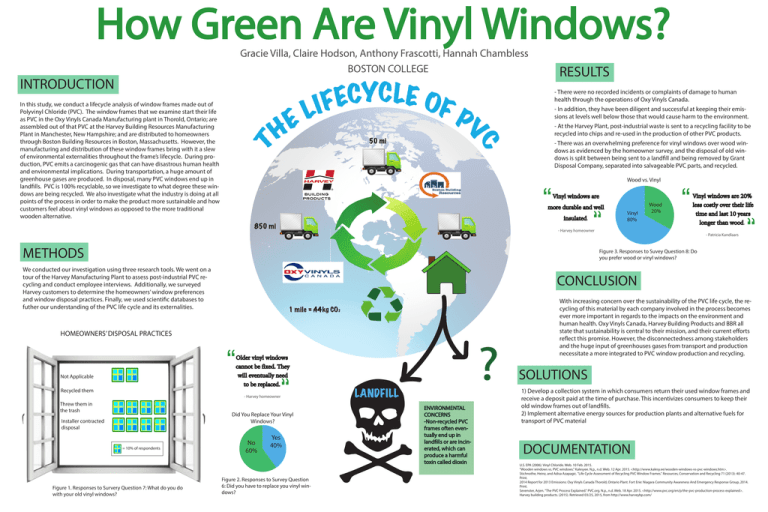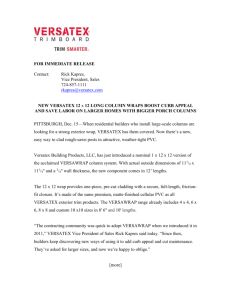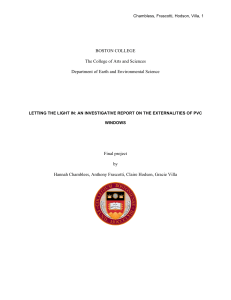How Green Are Vinyl Windows? RESULTS INTRODUCTION
advertisement

How Green Are Vinyl Windows? Gracie Villa, Claire Hodson, Anthony Frascotti, Hannah Chambless BOSTON COLLEGE RESULTS INTRODUCTION - There were no recorded incidents or complaints of damage to human health through the operations of Oxy Vinyls Canada. In this study, we conduct a lifecycle analysis of window frames made out of Polyvinyl Chloride (PVC). The window frames that we examine start their life as PVC in the Oxy Vinyls Canada Manufacturing plant in Thorold, Ontario; are assembled out of that PVC at the Harvey Building Resources Manufacturing Plant in Manchester, New Hampshire; and are distributed to homeowners through Boston Building Resources in Boston, Massachusetts. However, the manufacturing and distribution of these window frames bring with it a slew of environmental externalities throughout the frame’s lifecycle. During production, PVC emits a carcinogenic gas that can have disastrous human health and environmental implications. During transportation, a huge amount of greenhouse gases are produced. In disposal, many PVC windows end up in landfills. PVC is 100% recyclable, so we investigate to what degree these windows are being recycled. We also investigate what the industry is doing at all points of the process in order to make the product more sustainable and how customers feel about vinyl windows as opposed to the more traditional wooden alternative. - In addition, they have been diligent and successful at keeping their emissions at levels well below those that would cause harm to the environment. - At the Harvey Plant, post-industrial waste is sent to a recycling facility to be recycled into chips and re-used in the production of other PVC products. 50 mi - There was an overwhelming preference for vinyl windows over wood windows as evidenced by the homeowner survey, and the disposal of old windows is split between being sent to a landfill and being removed by Grant Disposal Company, separated into salvageable PVC parts, and recycled. “ Wood vs. Vinyl Vinyl windows are more durable and well 850 mi insulated. “ Vinyl 80% Wood 20% “ Vinyl windows are 20% less costly over their life time and last 10 years - Harvey homeowner METHODS longer than wood. - Patricia Kandlaars “ Figure 3. Responses to Suvey Question 8: Do you prefer wood or vinyl windows? We conducted our investigation using three research tools. We went on a tour of the Harvey Manufacturing Plant to assess post-industrial PVC recycling and conduct employee interviews. Additionally, we surveyed Harvey customers to determine the homeowners’ window preferences and window disposal practices. Finally, we used scientific databases to futher our understanding of the PVC life cycle and its externalities. CONCLUSION 1 mile = 4 . 4kg CO2 HOMEOWNERS’ DISPOSAL PRACTICES “ Not Applicable cannot be fixed. They will eventually need to be replaced. Recycled them - Harvey homeowner Threw them in the trash “ Did You Replace Your Vinyl Windows? Installer contracted disposal = 10% of respondents Figure 1. Responses to Survery Question 7: What do you do with your old vinyl windows? ? Older vinyl windows No 60% Yes 40% Figure 2. Responses to Survey Question 6: Did you have to replace you vinyl windows? LANDFILL ENVIRONMENTAL CONCERNS -Non-recycled PVC frames often eventually end up in landfills or are incinerated, which can produce a harmful toxin called dioxin With increasing concern over the sustainability of the PVC life cycle, the recycling of this material by each company involved in the process becomes ever more important in regards to the impacts on the environment and human health. Oxy Vinyls Canada, Harvey Building Products and BBR all state that sustainability is central to their mission, and their current efforts reflect this promise. However, the disconnectedness among stakeholders and the huge input of greenhouses gases from transport and production necessitate a more integrated to PVC window production and recycling. SOLUTIONS 1) Develop a collection system in which consumers return their used window frames and receive a deposit paid at the time of purchase. This incentivizes consumers to keep their old window frames out of landfills. 2) Implement alternative energy sources for production plants and alternative fuels for transport of PVC material DOCUMENTATION U.S. EPA (2006). Vinyl Chloride. Web. 10 Feb. 2015. "Wooden windows vs. PVC windows." Kalesyee. N.p., n.d. Web. 12 Apr. 2015. <http://www.kalesy.ee/wooden-windows-vs-pvc-windows.htm>. Stichnothe, Heinz, and Adisa Azapagic. "Life Cycle Assessment of Recycling PVC Window Frames." Resources, Conservation and Recycling 71 (2013): 40-47. Print. 2014 Report for 2013 Emissions: Oxy Vinyls Canada Thorold, Ontario Plant. Fort Erie: Niagara Community Awareness And Emergency Response Group, 2014. Print. Sevenster, Arjen. "The PVC Process Explained." PVC.org. N.p., n.d. Web. 18 Apr. 2015. <http://www.pvc.org/en/p/the-pvc-production-process-explained>. Harvey building products. (2015). Retrieved 03/25, 2015, from http://www.harveybp.com/




